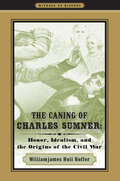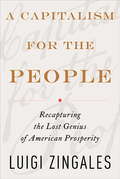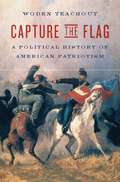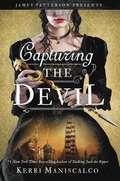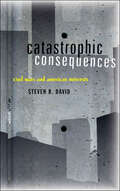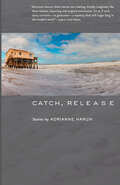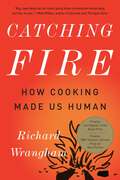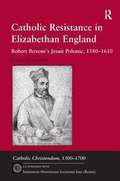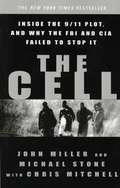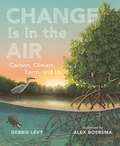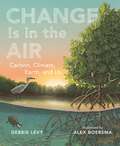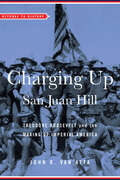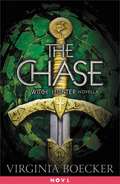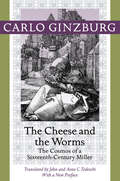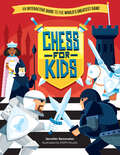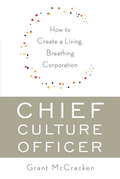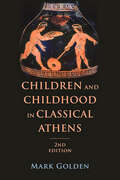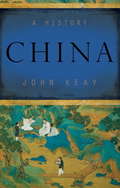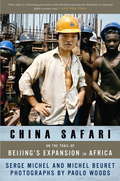- Table View
- List View
The Caning of Charles Sumner: Honor, Idealism, and the Origins of the Civil War (Witness to History)
by Williamjames Hull HofferA signal, violent event in the history of the United States Congress, the caning of Charles Sumner on the Senate floor embodied the complex North-South cultural divide of the mid-nineteenth century. Williamjames Hull Hoffer's vivid account of the brutal act demonstrates just how far the sections had drifted apart and explains why the coming war was so difficult to avoid. Sumner, a noted abolitionist and gifted speaker, was seated at his Senate desk on May 22, 1856, when Democratic Congressman Preston S. Brooks approached, pulled out a gutta-percha walking stick, and struck him on the head. Brooks continued to beat the stunned Sumner, forcing him to the ground and repeatedly striking him even as the cane shattered. He then pursued the bloodied, staggering Republican senator up the Senate aisle until Sumner collapsed at the feet of Congressman Edwin B. Morgan. Colleagues of the two intervened only after Brooks appeared intent on beating the unconscious Sumner severely—and, perhaps, to death. Sumner's crime? Speaking passionately about the evils of slavery, which dishonored both the South and Brooks’s relative, Senator Andrew P. Butler. Celebrated in the South for the act, Brooks was fined only three hundred dollars, dying a year later of a throat infection. Sumner recovered and served out a distinguished Senate career until his death in 1873.Hoffer's narrative recounts the caning and its aftermath, explores the depths of the differences between free and slave states in 1856, and explains the workings of the Southern honor culture as opposed to Yankee idealism. Hoffer helps us understand why Brooks would take such great offense at a political speech and why he chose a cane—instead of dueling with pistols or swords—to meet his obligation under the South’s prevailing code of honor. He discusses why the courts meted out a comparatively light sentence. He addresses the importance of the event in the national crisis and shows why such actions are not quite as alien to today’s politics as they might at first seem.
A Capitalism for the People: Recapturing the Lost Genius of American Prosperity
by Luigi ZingalesBorn in Italy, University of Chicago economist Luigi Zingales witnessed firsthand the consequences of high inflation and unemployment-paired with rampant nepotism and cronyism-on a country's economy. This experience profoundly shaped his professional interests, and in 1988 he arrived in the United States, armed with a political passion and the belief that economists should not merely interpret the world, but should change it for the better.In A Capitalism for the People, Zingales makes a forceful, philosophical, and at times personal argument that the roots of American capitalism are dying, and that the result is a drift toward the more corrupt systems found throughout Europe and much of the rest of the world. American capitalism, according to Zingales, grew in a unique incubator that provided it with a distinct flavor of competitiveness, a meritocratic nature that fostered trust in markets and a faith in mobility. Lately, however, that trust has been eroded by a betrayal of our pro-business elites, whose lobbying has come to dictate the market rather than be subject to it, and this betrayal has taken place with the complicity of our intellectual class.Because of this trend, much of the country is questioning-often with great anger-whether the system that has for so long buoyed their hopes has now betrayed them once and for all. What we are left with is either anti-market pitchfork populism or pro-business technocratic insularity. Neither of these options presents a way to preserve what the author calls "the lighthouse” of American capitalism. Zingales argues that the way forward is pro-market populism, a fostering of truly free and open competition for the good of the people-not for the good of big business.Drawing on the historical record of American populism at the turn of the twentieth century, Zingales illustrates how our current circumstances aren't all that different. People in the middle and at the bottom are getting squeezed, while people at the top are only growing richer. The solutions now, as then, are reforms to economic policy that level the playing field. Reforms that may be anti-business (specifically anti-big business), but are squarely pro-market. The question is whether we can once again muster the courage to confront the powers that be.
A Capitalism for the People: Recapturing the Lost Genius of American Prosperity
by Luigi ZingalesBorn in Italy, University of Chicago economist Luigi Zingales witnessed firsthand the consequences of high inflation and unemployment -- paired with rampant nepotism and cronyism -- on a country's economy. This experience profoundly shaped his professional interests, and in 1988 he arrived in the United States, armed with a political passion and the belief that economists should not merely interpret the world, but should change it for the better. In A Capitalism for the People, Zingales makes a forceful, philosophical, and at times personal argument that the roots of American capitalism are dying, and that the result is a drift toward the more corrupt systems found throughout Europe and much of the rest of the world. American capitalism, according to Zingales, grew in a unique incubator that provided it with a distinct flavor of competitiveness, a meritocratic nature that fostered trust in markets and a faith in mobility. Lately, however, that trust has been eroded by a betrayal of our pro-business elites, whose lobbying has come to dictate the market rather than be subject to it, and this betrayal has taken place with the complicity of our intellectual class. Because of this trend, much of the country is questioning -- often with great anger -- whether the system that has for so long buoyed their hopes has now betrayed them once and for all. What we are left with is either anti-market pitchfork populism or pro-business technocratic insularity. Neither of these options presents a way to preserve what the author calls "the lighthouse" of American capitalism. Zingales argues that the way forward is pro-market populism, a fostering of truly free and open competition for the good of the people -- not for the good of big business. Drawing on the historical record of American populism at the turn of the twentieth century, Zingales illustrates how our current circumstances aren't all that different. People in the middle and at the bottom are getting squeezed, while people at the top are only growing richer. The solutions now, as then, are reforms to economic policy that level the playing field. Reforms that may be anti-business (specifically anti-big business), but are squarely pro-market. The question is whether we can once again muster the courage to confront the powers that be.
Capture the Flag: A Political History of American Patriotism
by Woden TeachoutAmericans honor the flag with a fervor seen in few other countries: The Stars and Stripes decorate American homes and businesses; wave over sports events and funerals; and embellish everything from politicians' lapels to the surface of the moon.But what does the flag mean? In Capture the Flag, historian Woden Teachout reveals that it has held vastly different meanings over time. It has been claimed by both the right and left; by racists and revolutionaries; by immigrants and nativists. In tracing the political history of the flag from its origins in the American Revolution through the present day, Teachout demonstrates that the shifting symbolism of the flag reveals a broader shift in the definition of American patriotism.A story of a nation in search of itself, Capture the Flag offers a probing account of the flag that has become America's icon.
Capturing the Devil (Stalking Jack the Ripper #4)
by Kerri ManiscalcoIn the shocking finale to the bestselling series that began with Stalking Jack the Ripper, Audrey Rose and Thomas are on the hunt for the depraved, elusive killer known as the White City Devil. A deadly game of cat-and-mouse has them fighting to stay one step ahead of the brilliant serial killer---or see their fateful romance cut short by unspeakable tragedy.Audrey Rose Wadsworth and Thomas Cresswell have landed in America, a bold, brash land unlike the genteel streets of London. But like London, the city of Chicago hides its dark secrets well. When the two attend the spectacular World's Fair, they find the once-in-a-lifetime event tainted with reports of missing people and unsolved murders. Determined to help, Audrey Rose and Thomas begin their investigations, only to find themselves facing a serial killer unlike any they've encountered before. Identifying him is one thing, but capturing him---and getting dangerously lost in the infamous Murder Hotel he constructed as a terrifying torture device---is another. Will Audrey Rose and Thomas see their last mystery to the end---together and in love---or will their fortunes finally run out when their most depraved adversary makes one final, devastating kill?
Catastrophic Consequences: Civil Wars and American Interests
by Steven R. DavidCivil war and other types of radical domestic upheaval are replacing international war as the preeminent threat to American security and economic well being, according to Steven R. David. Catastrophic Consequences argues that civil conflicts are of even greater importance than deliberate efforts to harm the United States because the damage they inflict is unintended and therefore impossible to deter.David examines the prospects for and potential aftereffects of instability in four nations vital to U.S. national interests—Saudi Arabia, Pakistan, China, and Mexico. It is not, he argues, a rising China that threatens America, but one that is falling apart. Likewise, it is not a hostile Pakistani regime over which the United States should worry, rather it is one that cannot keep the country together. Similarly, a conflict-torn Mexico or Saudi Arabia poses a far greater danger to America than does either of those states growing stronger. In assessing these threats, David contends that the United States’s only viable option is to view other-state civil upheaval similarly to natural disasters and to develop a coherent, effective emergency response mechanism, which does not exist today in any systemic, nationwide form.
Catch, Release: Stories (Johns Hopkins: Poetry and Fiction)
by Adrianne HarunIt;€™s all about loss. Don;€™t kid yourself. Even a simple game of catch is hinged on the moment the ball leaves the glove, the moment it returns. Don;€™t even try to think this story or any other story is about something else.In Catch, Release, Adrianne Harun;€™s second story collection, loss is the driver. But it;€™s less the usual somber shadow-figure of grieving than an erratically interesting cousin, unmoored, even exhilarated, by the sudden flight into emptiness, the freedom of being neither here nor there. In this suspended state, anything might happen;¢;‚¬;€?and it does. Harun;€™s most realistic stories are suffused with mystery, while her more fantastic tales reveal startling truths within the commonplace. In diverse settings that include, among other places, a British Columbian island, a haunted Midwestern farmhouse, a London townhome, and a dementia care facility overpopulated with dangerously idle guardian angels, characters reconfigure whole worlds as they navigate states defined by absence. In "The Farmhouse Wife," a young couple, struggling financially, takes up residence in a near-abandoned farmhouse, only to be joined by an inconvenient roommate, a woman whose own bereft state proves perilously seductive. A kleptomaniac father gets caught in one of his petty thefts in "Pearl Diving," propelling his two sons out of one life into another, perhaps more appropriate, one. In "Madame Ida," a family of little girls steadily invades a woman;€™s life as she puzzles out the mysteries of a missing sheriff-turned-cult-leader and the absence of her own son. And in the title story, two teenagers face off against the hurtful lies of an ancient con woman who is mining a widow;€™s grief for her own ends.Adrianne Harun has been described as an exacting and attentive stylist whose stories are rendered in vivid language. The Los Angeles Review of Books wrote of her work: "Harun finds beauty in pitch black; she makes poetry out of brutality and grace out of terror. She is an alchemist, turning the worst aspects of life into gold." With Catch, Release, Harun upends the world once more.
Catch, Release (Johns Hopkins: Poetry and Fiction)
by Adrianne HarunIt;€™s all about loss. Don;€™t kid yourself. Even a simple game of catch is hinged on the moment the ball leaves the glove, the moment it returns. Don;€™t even try to think this story or any other story is about something else.In Catch, Release, Adrianne Harun;€™s second story collection, loss is the driver. But it;€™s less the usual somber shadow-figure of grieving than an erratically interesting cousin, unmoored, even exhilarated, by the sudden flight into emptiness, the freedom of being neither here nor there. In this suspended state, anything might happen;¢;‚¬;€?and it does. Harun;€™s most realistic stories are suffused with mystery, while her more fantastic tales reveal startling truths within the commonplace. In diverse settings that include, among other places, a British Columbian island, a haunted Midwestern farmhouse, a London townhome, and a dementia care facility overpopulated with dangerously idle guardian angels, characters reconfigure whole worlds as they navigate states defined by absence. In "The Farmhouse Wife," a young couple, struggling financially, takes up residence in a near-abandoned farmhouse, only to be joined by an inconvenient roommate, a woman whose own bereft state proves perilously seductive. A kleptomaniac father gets caught in one of his petty thefts in "Pearl Diving," propelling his two sons out of one life into another, perhaps more appropriate, one. In "Madame Ida," a family of little girls steadily invades a woman;€™s life as she puzzles out the mysteries of a missing sheriff-turned-cult-leader and the absence of her own son. And in the title story, two teenagers face off against the hurtful lies of an ancient con woman who is mining a widow;€™s grief for her own ends.Adrianne Harun has been described as an exacting and attentive stylist whose stories are rendered in vivid language. The Los Angeles Review of Books wrote of her work: "Harun finds beauty in pitch black; she makes poetry out of brutality and grace out of terror. She is an alchemist, turning the worst aspects of life into gold." With Catch, Release, Harun upends the world once more.
Catching Fire: How Cooking Made Us Human
by Richard WranghamThe groundbreaking theory of how fire and food drove the evolution of modern humansEver since Darwin and The Descent of Man, the evolution and world-wide dispersal of humans has been attributed to our intelligence and adaptability. But in Catching Fire, renowned primatologist Richard Wrangham presents a startling alternative: our evolutionary success is the result of cooking. In a groundbreaking theory of our origins, Wrangham shows that the shift from raw to cooked foods was the key factor in human evolution. Once our hominid ancestors began cooking their food, the human digestive tract shrank and the brain grew. Time once spent chewing tough raw food could be sued instead to hunt and to tend camp. Cooking became the basis for pair bonding and marriage, created the household, and even led to a sexual division of labor. In short, once our ancestors adapted to using fire, humanity began. Tracing the contemporary implications of our ancestors' diets, Catching Fire sheds new light on how we came to be the social, intelligent, and sexual species we are today. A pathbreaking new theory of human evolution, Catching Fire will provoke controversy and fascinate anyone interested in our ancient origins-or in our modern eating habits.
Catholic Resistance in Elizabethan England: Robert Persons's Jesuit Polemic, 1580-1610 (PDF)
by Victor HoulistonDuring his lifetime, the Jesuit priest Robert Persons (1546-1610) was arguably the leading figure fighting for the re-establishment of Catholicism in England. Whilst his colleague Edmund Campion may now be better known it was Persons's tireless efforts that kept the Jesuit mission alive during the difficult days of Elizabeth's reign. In this new study, Person's life and phenomenal literary output are analysed and put into the broader context of recent Catholic scholarship. The book bridges the gap between historical studies, on the one hand, and literary studies on the other, by concentrating on Persons's contribution as a writer to the polemical culture of the late sixteenth and early seventeenth centuries.As well as discussing his wider achievements as leader of the English Jesuits - founding three seminaries for English priests, corresponding regularly with Catholic activists in England, writing over thirty books, holding the post of rector of the English College in Rome, and being a trusted consultant to the papacy on English affairs - this study looks in detail at what is arguably his greatest legacy, The First Booke of the Christian Exercise (more commonly known as the Book of Resolution). That book, first published in 1582, was to prove the cornerstone of Persons's missionary effort, and a popular work of Catholic devotion, running to several editions over the coming years.Although Persons was ultimately unsuccessful in his ambition to return England to the Catholic fold, the story of his life and works reveals much about the ecclesiastical struggle that gripped early modern Europe. By providing a thorough and up-to-date reassessment of Persons this study not only makes a significant contribution to our understanding of the polemical context of post-Reformation Catholicism, but also of the Jesuit notion of the 'apostolate of writing'.This book is published in conjunction with the Jesuit Historical Institute series 'Bibliotheca Instituti Historici Societatis Iesu'.
The Cell: Inside the 9/11 Plot, and Why the FBI and CIA Failed to Stop It (Basic Ser.)
by John C. Miller Michael Stone Chris MitchellIn The Cell, John Miller, an award-winning journalist and coanchor of ABC's 20/20, along with veteran reporter Michael Stone and Chris Mitchell, takes readers back more than 10 years to the birth of the terrorist cell that later metastasized into al Qaeda's New York operation. This remarkable book offers a firsthand account of what it is to be a police officer, an FBI agent or a reporter obsessed with a case few people will take seriously. It contains a first-person account of Miller's face-to-face meeting with bin Laden and provides the first full-length treatment to piece together what led up to the events of 9/11, ultimately delivering the disturbing answer to the question: Why, with all the information the intelligence community had, was no one able to stop the 9/11 attacks?
The Cell: Inside the 9/11 Plot, and Why the FBI and CIA Failed to Stop It
by John C. Miller Michael Stone Chris MitchellSeptember 11, 2001 marked the beginning of a new era in history, but the forces that triggered those attacks have been in place for years and continue to operate within the United States and abroad. Experts estimate that as many as 500 terrorist cells exist in America today. ABC News journalist John Miller has been tracking this story since his coverage of the first World Trade Center bombing in 1993. He was the first American journalist to interview Osama Bin Laden, and he has a sophisticated knowledge of the structure and workings of extremist organizations. The Cell contains information gleaned from sources within the FBI, CIA, and the local law enforcement communities currently conducting the investigation into the September 11 attacks.
Change Is in the Air: Carbon, Climate, Earth, and Us
by Debbie LevyA nonfiction picture book about amazing ways that the Earth removes carbon from the air, and amazing ways people can help, offering a fresh and hopeful perspective on climate change.The Earth has a problem: there's too much carbon in the air. Luckily, the Earth also has amazing powers to remove carbon dioxide from the atmosphere-like the power of kelp, mangroves, and dirt. Although these powers alone cannot get us out of the climate crisis we're facing, the Earth has another important power: the power of people! People have the power to change, protect, innovate, and invent. In this informational picture book, Debbie Levy and Alex Boersma paint an encouraging yet honest picture of the problems at hand and some of the ways that we can address them. Thanks to the power of nature and the ingenuity of people, change is in the air!
Change Is in the Air: Carbon, Climate, Earth, and Us
by Debbie LevyA nonfiction picture book about amazing ways that the Earth removes carbon from the air, and amazing ways people can help, offering a fresh and hopeful perspective on climate change.The Earth has a problem: there's too much carbon in the air. Luckily, the Earth also has amazing powers to remove carbon dioxide from the atmosphere-like the power of kelp, mangroves, and dirt. Although these powers alone cannot get us out of the climate crisis we're facing, the Earth has another important power: the power of people! People have the power to change, protect, innovate, and invent. In this informational picture book, Debbie Levy and Alex Boersma paint an encouraging yet honest picture of the problems at hand and some of the ways that we can address them. Thanks to the power of nature and the ingenuity of people, change is in the air!
The Chaos Frontier: Creative Strategic Control for Business (PDF)
by Ralph D StaceyThe purpose of this book is to introduce senior business executives to a new scientific way of explaining the creative behaviour of dynamic systems, one of which is the successful business organization.
Charging Up San Juan Hill: Theodore Roosevelt and the Making of Imperial America (Witness to History)
by John R. Van AttaBelow a Cuban sun so hot it stung their eyes, American troops hunkered low at the base of Kettle Hill. Spanish bullets zipped overhead, while enemy artillery shells landed all around them. Driving Spanish forces from the high ground would mean gaining control of Santiago, Cuba, and, soon enough, American victory in the Spanish-American War. No one doubted that enemy fire would claim a heavy toll, but these unusual citizen-soldiers and their unlikely commander;¢;‚¬;€?39-year-old Colonel Theodore Roosevelt;¢;‚¬;€?had volunteered for exactly this kind of mission.In Charging Up San Juan Hill, John R. Van Atta recounts that fateful day in 1898. Describing the battle;€™s background and its ramifications for Roosevelt, both personal and political, Van Atta explains how Roosevelt;€™s wartime experience prompted him to champion American involvement in world affairs. Tracking Roosevelt;€™s rise to the presidency, this book argues that the global expansion of American influence;¢;‚¬;€?indeed, the building of an empire outward from a strengthened core of shared values at home;¢;‚¬;€?connected to the broader question of cultural sustainability as much as it did to the increasing of trade, political power, and military might.At the turn of the twentieth century, Theodore Roosevelt personified American confidence. A New York City native and recovered asthmatic who spent his twenties in the wilds of the Dakota Territory, Roosevelt leapt into the war with Spain with gusto. He organized a band of cavalry volunteers he called the Rough Riders and, on July 1, 1898, took part in their charge up a Cuban hill the newspapers called San Juan, launching him to national prominence. Without San Juan, Van Atta argues, Roosevelt;¢;‚¬;€?whom the papers credited for the victory and lauded as a paragon of manhood;¢;‚¬;€?would never have reached a position to become president.
Charging Up San Juan Hill: Theodore Roosevelt and the Making of Imperial America (Witness to History)
by John R. Van AttaBelow a Cuban sun so hot it stung their eyes, American troops hunkered low at the base of Kettle Hill. Spanish bullets zipped overhead, while enemy artillery shells landed all around them. Driving Spanish forces from the high ground would mean gaining control of Santiago, Cuba, and, soon enough, American victory in the Spanish-American War. No one doubted that enemy fire would claim a heavy toll, but these unusual citizen-soldiers and their unlikely commander;¢;‚¬;€?39-year-old Colonel Theodore Roosevelt;¢;‚¬;€?had volunteered for exactly this kind of mission.In Charging Up San Juan Hill, John R. Van Atta recounts that fateful day in 1898. Describing the battle;€™s background and its ramifications for Roosevelt, both personal and political, Van Atta explains how Roosevelt;€™s wartime experience prompted him to champion American involvement in world affairs. Tracking Roosevelt;€™s rise to the presidency, this book argues that the global expansion of American influence;¢;‚¬;€?indeed, the building of an empire outward from a strengthened core of shared values at home;¢;‚¬;€?connected to the broader question of cultural sustainability as much as it did to the increasing of trade, political power, and military might.At the turn of the twentieth century, Theodore Roosevelt personified American confidence. A New York City native and recovered asthmatic who spent his twenties in the wilds of the Dakota Territory, Roosevelt leapt into the war with Spain with gusto. He organized a band of cavalry volunteers he called the Rough Riders and, on July 1, 1898, took part in their charge up a Cuban hill the newspapers called San Juan, launching him to national prominence. Without San Juan, Van Atta argues, Roosevelt;¢;‚¬;€?whom the papers credited for the victory and lauded as a paragon of manhood;¢;‚¬;€?would never have reached a position to become president.
The Chase: A Witch Hunter Novella (The Witch Hunter)
by Virginia BoeckerA witch and a revenant. One full of life, the other technically dead. Fifer and Schuyler's relationship is nothing if not unusual. Some might even call it ill-advised. But try as they might to push each other away, something keeps bringing them back together.Then a force stronger than their attraction comes between them: Lord Blackwell, the Inquisitor and most powerful man in Anglia. He sends Schuyler on a mission--a mythical sword, rumored to make its owner invincible, lies somewhere in Anglia and it's Schuyler's job to find it.Meanwhile, left behind in Harrow with her studies, Fifer can't help but worry what's become of her undead paramour. Schuyler's been missing for weeks and Fifer may be the one who can--or who cares enough to--find him.An enthralling new Witch Hunter series novella. Word Count: ~19,000
The Cheese and the Worms: The Cosmos of a Sixteenth-Century Miller
by Carlo GinzburgThe Cheese and the Worms is an incisive study of popular culture in the sixteenth century as seen through the eyes of one man, the miller known as Menocchio, who was accused of heresy during the Inquisition and sentenced to death. Carlo Ginzburg uses the trial records to illustrate the religious and social conflicts of the society Menocchio lived in. For a common miller, Menocchio was surprisingly literate. In his trial testimony he made references to more than a dozen books, including the Bible, Boccaccio's Decameron, Mandeville's Travels, and a "mysterious" book that may have been the Koran. And what he read he recast in terms familiar to him, as in his own version of the creation: "All was chaos, that is earth, air, water, and fire were mixed together; and of that bulk a mass formed—just as cheese is made out of milk—and worms appeared in it, and these were the angels."Ginzburg’s influential book has been widely regarded as an early example of the analytic, case-oriented approach known as microhistory. In a thoughtful new preface, Ginzburg offers his own corollary to Menocchio’s story as he considers the discrepancy between the intentions of the writer and what gets written. The Italian miller’s story and Ginzburg’s work continue to resonate with modern readers because they focus on how oral and written culture are inextricably linked. Menocchio’s 500-year-old challenge to authority remains evocative and vital today.
The Cheese and the Worms: The Cosmos of a Sixteenth-Century Miller
by Carlo GinzburgThe Cheese and the Worms is an incisive study of popular culture in the sixteenth century as seen through the eyes of one man, the miller known as Menocchio, who was accused of heresy during the Inquisition and sentenced to death. Carlo Ginzburg uses the trial records to illustrate the religious and social conflicts of the society Menocchio lived in. For a common miller, Menocchio was surprisingly literate. In his trial testimony he made references to more than a dozen books, including the Bible, Boccaccio's Decameron, Mandeville's Travels, and a "mysterious" book that may have been the Koran. And what he read he recast in terms familiar to him, as in his own version of the creation: "All was chaos, that is earth, air, water, and fire were mixed together; and of that bulk a mass formedâ€�just as cheese is made out of milkâ€�and worms appeared in it, and these were the angels."Ginzburg’s influential book has been widely regarded as an early example of the analytic, case-oriented approach known as microhistory. In a thoughtful new preface, Ginzburg offers his own corollary to Menocchio’s story as he considers the discrepancy between the intentions of the writer and what gets written. The Italian miller’s story and Ginzburg’s work continue to resonate with modern readers because they focus on how oral and written culture are inextricably linked. Menocchio’s 500-year-old challenge to authority remains evocative and vital today.
Chess for Kids: An Interactive Guide to the World's Greatest Game
by Jennifer KemmeterThis engaging workbook introduces kids to the wonderful world of chess—from an explanation of every piece on the board to the fundamentals of the game and strategies to capture pieces and win—all told through fun visuals, mock games, and exciting exercises. Chess for Kids includes:A comprehensive introduction to the king, queen, knights, bishops, rooks, and pawns and how each piece moves, attacks, and defends.Detailed explanations of the basic rules of chess, tactics, strategies, mating patterns, and piece strategies.Write-in, workbook activities to help kids &‘learn by doing,&’ unlike other chess books which are text heavy and not interactive. The best offensive and defensive strategies including how to find weak spots in your opponent's defense and how to close games when most of the board&’s pieces are gone.Learn the pieces, study the strategies, and checkmate all your opponents in this complete guide to mastering the game of chess!
Chief Culture Officer: How to Create a Living, Breathing Corporation
by Grant McCrackenTrenchantly on point and bursting with insight, anthropologist Grant McCracken shows American corporations how keeping a finger on the pulse of contemporary cultural trends can change their business practices for the better -- and ahead of the curve.Levi-Strauss, the jeans and apparel maker, missed out on the hip-hop trend. They didn't realize that those kids in baggy jeans represented a whole new -- and lucrative -- market opportunity, one they could have seen coming if they had but been paying attention to the shape of American culture. Levi Strauss isn't alone. Too many corporations outsource their understanding of culture to trend hunters, cool watchers, marketing experts, consulting firms, and, sometimes, teenage interns. The cost to Levi-Strauss was a billion dollars. The cost to the rest of corporate America is immeasurable. The lesson? The American corporation needs a new professional. It needs a Chief Culture Officer. Grant McCracken, an anthropologist who now trains some of the world's biggest companies and consulting firms, argues that the CCO would keep a finger on the pulse of contemporary cultural trends-from sneakers to slow food to preppies-while developing a systematic understanding of the deep waves of culture in America and the world. The CCO's professionalism would allow the corporation to see coming changes, even when they only exist as the weakest of signals. Delightfully authoritative, trenchantly on point, bursting with insight and character, Chief Culture Officer is sure to expand your horizons-and your business.
Children and Childhood in Classical Athens (Ancient Society and History)
by Mark GoldenFirst published in 1990, Children and Childhood in Classical Athens was the first book in English to explore the lives of children in ancient Athens. Drawing on literary, artistic, and archaeological sources as well as on comparative studies of family history, Mark Golden offers a vivid portrait of the public and private lives of children from about 500 to 300 B.C. Golden discusses how the Athenians viewed children and childhood, describes everyday activities of children at home and in the community, and explores the differences in the social lives of boys and girls. He details the complex bonds among children, parents, siblings, and household slaves, and he shows how a growing child’s changing roles often led to conflict between the demands of family and the demands of community.In this thoroughly revised edition, Golden places particular emphasis on the problem of identifying change over time and the relationship of children to adults. He also explores three dominant topics in the recent historiography of childhood: the agency of children, the archaeology of childhood, and representations of children in art. The book includes a completely new final chapter, text and notes rewritten throughout to incorporate evidence and scholarship that has appeared over the past twenty-five years, and an index of ancient sources.
China: A History
by John KeayAn authoritative account of five thousand years of Chinese historyMany nations define themselves in terms of territory or people; China defines itself in terms of history. Taking into account the country's unrivaled, voluminous tradition of history writing, John Keay has composed a vital and illuminating overview of the nation's complex and vivid past. Keay's authoritative history examines 5,000 years in China, from the time of the Three Dynasties through Chairman Mao and the current economic transformation of the country. Crisp, judicious, and engaging, China is the classic single-volume history for anyone seeking to understand the present and future of this immensely powerful nation.
China Safari: On the Trail of Beijing's Expansion in Africa
by Serge Michel Michel BeuretChina has now taken Great Britain's place as Africa's third largest business partner. Where others only see chaos, the Chinese see opportunities. With no colonial past and no political preconditions, China is bringing investment and needed infrastructure to a continent that has been largely ignored by Western companies or nations.Traveling from Beijing to Khartoum, Algiers to Brazzaville, the authors tell the story of China's economic ventures in Africa. What they find is tantamount to a geopolitical earthquake: The possibility that China will help Africa direct its own fate and finally bring light to the so-called "dark continent,” making it a force to be reckoned with internationally.
